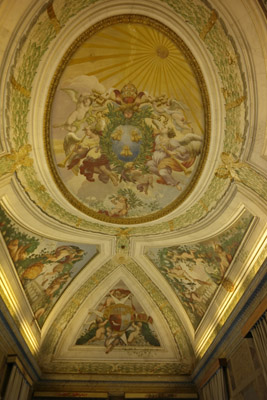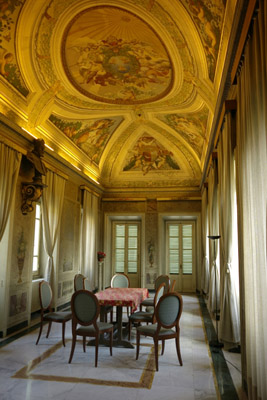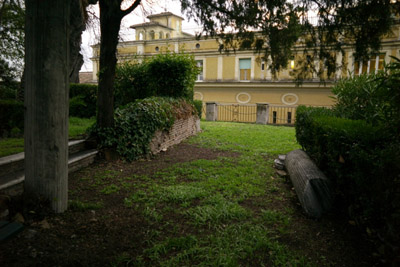 |
Sharing the Experience of the Congregation Fr. Don Doll, S.J. took the
photos << previous entry ...... next entry >> |
|
|
Dave Schultenover, S.J. is a delegate to the Congregation from the Wisconsin Province, in the US Assistancy. He is a Consultor to the Provincial of the Wisconsin Province and a professor of historical theology at Marquette University. He is the editor in chief of THEOLOGICAL STUDIES, A Jesuit Sponsored Journal of Theology. |
Here are photos of my salon and gardens, courtesy of my photographer. The first two photos are from inside my home — what was originally designed as a formal parlor, painted in the rococo baroque style. The other two photos are of Agrippina’s garden outside my window. We could have some very deep conversations here. . . .
Just to be clear about these photos: This is the only room in the house so painted. The rest is spartan by US standards, but clean. No rugs on the floors, not even in the bathrooms. Just tile. No artwork in the rooms, unless the inhabitants put it up — something we visitors are unlikely to do, or be allowed to do — and almost no artwork in the common areas. I shudder to think of what might have been destroyed when the Society converted the Barberini home to a retreat house — although almost certainly by 1900 the murals and other interior artwork would have needed extensive restoration, which the Society could ill afford. It’s also likely that the previous owners and inhabitants had not preserved the original artworks.
I asked Don Doll if he wanted me in the photo as another putto (a statue of a child in Renaisance art). He said no. . . . (You know, despite his many awards, the man still needs some work.) We congregants are working hard, in short plenary sessions (for prayer and announcements), in assistancy groupings, and in small (ca. 10 members) and intermediate-size (ca. 20) language groupings. Listening intently to so many different languages or even to English in many different accents and dialects is wearying. But good. Yesterday at lunch I was involved in a 4-way conversation in four languages. Yikes! The work days are long and wearying. We have been in session ca. 7 hrs/day so far, but outside those times we have to read resource materials and prepare reports. What most impresses me so far is how well the work of the coetus praevius (preliminary organizing committee) prepared the delegates around the world. We are surprisingly united on the big issues, at least so far. I will not be surprised to find out that, as the saying goes, we will find the devil in the details. I remain very hopeful that the congregation will (a) elect a very good general and (b) prepare helpful guiding documents. Orate pro nobis! Mille grazie. Davide ____ David G. Schultenover, S.J. |
 The
salon is in the Barberini summer home which the Society purchased ca.
1900 and converted into a retreat house (years ago when I was doing
research in the nearby Jesuit archives, I recall reading about the transaction
carried out by Fr. General Luis Martín). In 1953 it became the
House of Writers and the Historical Institute.
The
salon is in the Barberini summer home which the Society purchased ca.
1900 and converted into a retreat house (years ago when I was doing
research in the nearby Jesuit archives, I recall reading about the transaction
carried out by Fr. General Luis Martín). In 1953 it became the
House of Writers and the Historical Institute.  A
couple years ago the Historical Institute moved into the westernmost
section of the curia near the curia library (which
incorporated the library of the Historical Institute) and the archives
building, recently constructed in the southern embankment of the curia
gardens. There no longer is a House of Writers. The structure, renamed
Residenza San Pietro Canisio, now houses the province infirmary
(ground floor) and those who work in Vatican Radio.
A
couple years ago the Historical Institute moved into the westernmost
section of the curia near the curia library (which
incorporated the library of the Historical Institute) and the archives
building, recently constructed in the southern embankment of the curia
gardens. There no longer is a House of Writers. The structure, renamed
Residenza San Pietro Canisio, now houses the province infirmary
(ground floor) and those who work in Vatican Radio. The
powerful Barberini family was not beloved by all. They seem to have
put their stamp on everything in Rome. Tourist guides tire of pointing
out the three bees — the Barberini coat of arms — found
on numerous buildings and monuments, including Bernini's great bronze
baldacchino in St. Peter’s — a huge, spiral-columned
canopy soaring (lumbering?) over the “papal altar.” Bernini's
Barberini patron, Pope Urban VIII, had no qualms about stripping the
bronze from the Pantheon to provide Bernini the material to create this
startling structure. The Romans reacted with the famous quip, "Quod
non fecerunt barbari, fecerunt Barberini (What the barbarians did
not do [to Rome] the Barberini did).”
The
powerful Barberini family was not beloved by all. They seem to have
put their stamp on everything in Rome. Tourist guides tire of pointing
out the three bees — the Barberini coat of arms — found
on numerous buildings and monuments, including Bernini's great bronze
baldacchino in St. Peter’s — a huge, spiral-columned
canopy soaring (lumbering?) over the “papal altar.” Bernini's
Barberini patron, Pope Urban VIII, had no qualms about stripping the
bronze from the Pantheon to provide Bernini the material to create this
startling structure. The Romans reacted with the famous quip, "Quod
non fecerunt barbari, fecerunt Barberini (What the barbarians did
not do [to Rome] the Barberini did).”